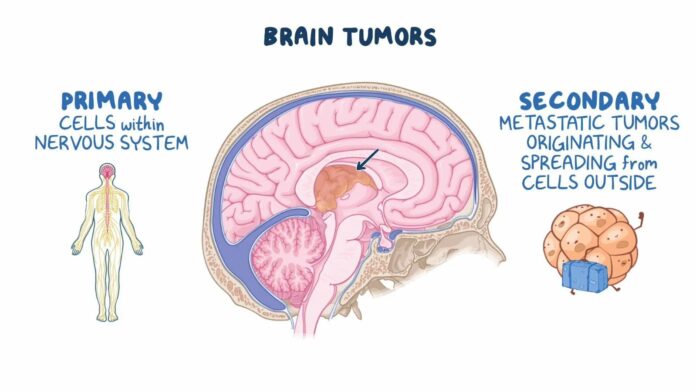Brain Tumors: A brain tumor is an abnormal growth of cells within the brain. It can be a terrifying diagnosis, and naturally, questions arise about its severity, symptoms, and potential treatments. Understanding these aspects is crucial for early detection and effective management.
Is a Brain Tumor Life-Threatening?
The simple answer is: a brain tumor can be life-threatening, but not all brain tumors are. The prognosis largely depends on several factors:
- Type of Tumor: Brain tumors are broadly categorized as benign (non-cancerous) or malignant (cancerous). While benign tumors grow slowly and typically don’t spread, they can still be dangerous if their growth presses on vital brain structures. Malignant tumors, on the other hand, grow rapidly, invade surrounding tissues, and can spread to other parts of the central nervous system.
- Grade of Tumor: Tumors are graded from I to IV, with Grade I being the least aggressive and Grade IV (like Glioblastoma) being the most aggressive and rapidly growing. Higher-grade tumors are generally more life-threatening.
- Location of Tumor: Even a benign tumor can be life-threatening if it’s located in a critical area of the brain that controls vital functions like breathing, heart rate, or consciousness. Tumors in surgically inaccessible areas also pose significant challenges.
- Size of Tumor: Larger tumors can exert more pressure on the brain, leading to more severe symptoms and potentially greater damage.
- Patient’s Overall Health and Age: The patient’s general health, age, and ability to tolerate treatment also play a significant role in the outcome.
While the phrase “brain tumor” often evokes fear, it’s important to remember that advancements in medical science have significantly improved outcomes for many patients. Early diagnosis and appropriate treatment are key to improving prognosis.
Is a Common Headache a Symptom?
This is a common concern, and the answer is sometimes, but rarely is a common headache the only symptom of a brain tumor. Headaches are an incredibly common ailment, and the vast majority are not indicative of a brain tumor.
However, headaches associated with brain tumors often have specific characteristics:
- Persistent and Worsening: Unlike typical tension or migraine headaches, brain tumor headaches tend to be persistent and gradually worsen over time. They might not respond to over-the-counter pain relievers.
- Worse in the Morning: Many individuals with brain tumors report that their headaches are worse upon waking in the morning, possibly due to increased intracranial pressure after lying down.
- Accompanied by Other Neurological Symptoms: This is a crucial differentiator. Headaches caused by brain tumors are almost always accompanied by other neurological signs or symptoms, which can include:
- Nausea and Vomiting: Especially if they occur without an obvious cause.
- Vision Problems: Blurred vision, double vision, loss of peripheral vision.
- Seizures: New-onset seizures in adults can be a significant indicator.
- Weakness or Numbness: On one side of the body.
- Changes in Personality or Behavior: Irritability, confusion, memory problems.
- Difficulty with Speech or Language: Slurred speech, trouble finding words.
- Balance Problems or Dizziness: Unexplained unsteadiness.
- Hearing Changes: Ringing in the ears or hearing loss.
If you experience persistent headaches, especially if they are worsening or accompanied by any of the above neurological symptoms, it is crucial to consult a doctor for a thorough evaluation.
What is the Treatment?
The treatment for a brain tumor is highly individualized and depends on the type, size, location, and grade of the tumor, as well as the patient’s overall health. A multidisciplinary team of specialists, including neurosurgeons, oncologists, radiation oncologists, and neurologists, typically develops the treatment plan.
Common treatment modalities include:
-
Surgery: This is often the first line of treatment for many brain tumors, especially if the tumor is accessible and can be safely removed without causing significant neurological damage. The goal is to remove as much of the tumor as possible (a procedure called gross total resection) while preserving brain function. In some cases, only a biopsy (removal of a small tissue sample for diagnosis) may be possible.
-
Radiation Therapy: This uses high-energy rays (like X-rays or protons) to kill tumor cells or shrink tumors. It can be used after surgery to destroy any remaining tumor cells, as a primary treatment if surgery isn’t possible, or to slow the growth of tumors that cannot be surgically removed. Different types of radiation therapy include:
- External Beam Radiation Therapy (EBRT): Delivers radiation from outside the body.
- Stereotactic Radiosurgery (SRS): A highly precise form of radiation that delivers a high dose to the tumor in one or a few sessions, minimizing damage to surrounding healthy tissue.
- Proton Beam Therapy: Uses protons instead of X-rays, which can be more precise in delivering radiation to the tumor with less exit dose.
-
Chemotherapy: This uses drugs to kill cancer cells. Chemotherapy can be administered orally, intravenously, or directly into the cerebrospinal fluid. It may be used in combination with surgery and/or radiation therapy, particularly for malignant tumors. Some common chemotherapy drugs for brain tumors include Temozolomide (Temodar) and Bevacizumab (Avastin).
-
Targeted Therapy: These drugs specifically target certain molecules involved in the growth and spread of cancer cells, often with fewer side effects than traditional chemotherapy. They are used for specific types of brain tumors that have particular genetic mutations or protein expressions.
-
Immunotherapy: This relatively newer approach uses the body’s own immune system to fight cancer. It works by boosting the immune response to recognize and attack tumor cells.
-
Supportive Care and Rehabilitation: Throughout and after treatment, supportive care is crucial to manage symptoms, side effects of treatment, and improve quality of life. This may include pain management, anti-nausea medications, steroids to reduce brain swelling, and rehabilitation therapies such as physical therapy, occupational therapy, and speech therapy to help patients regain lost functions.
Conclusion:
A brain tumor diagnosis is undoubtedly challenging, but it’s important to approach it with accurate information and hope. While some brain tumors are indeed life-threatening, advances in medical technology and treatment options offer significant hope for many patients.
Recognizing the potential symptoms, especially when common headaches are accompanied by other neurological changes, is vital for early detection and timely intervention, which are critical factors in achieving the best possible outcome. If you have concerns about any persistent or unusual symptoms, always consult a healthcare professional.

